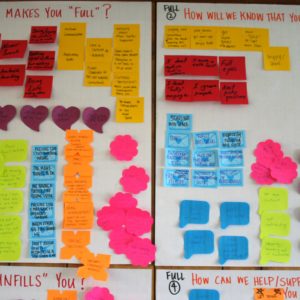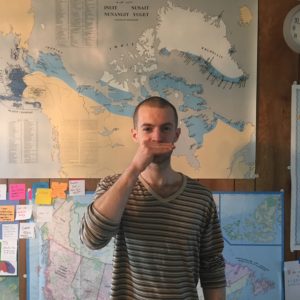
Evan (left) and I are working on cleaning the spaces between floorboards on the patio. The situation lent itself to a lot of Obviously!-made Set-ups and Same Conversations, while we were Whistling While We Worked throughout.
While I was helping Evan over the past few weeks improve his house to sell, I had some time to learn Spanish from him. We didn’t have to set aside some time for lessons. After all, language is about communication, not classroom exercises. We simply made a deal that if I wanted to help out Evan with his housework, he’d want to speak to me in a foreign language he knew well on the ACTFL scale, Spanish. Of the languages he knew and could teach me, Spanish was the one I saw as most useful and wanted to practice the most.
(Despite my name, I don’t come from a Spanish-speaking culture myself; my family just happens to be from the Philippines, a country where many people were given Spanish names. All spelling errors here, if any, are mine.)
At this point, I should bring up a new name we coined for a new technique: “Whistle While You Work.” Naturally, it takes a cue from Snow White and the Seven Dwarfs: doing something else while you work helps to make the job lighter on the learner and to give the fluent speaker more time to teach. While we were scraping dirt off the gaps between the floorboards on the patios and wiping down some walls inside the house, Evan brought up a lot of vocabulary words relevant to our tasks. Our conversations used lines like Nosotros limpiamos las paredes con trapos un poquito mojados. Cuantos huecos has encontrado en las paredes? The technique combines a handful of other techniques that connect language to real, live activities:
- “Be Here Now” (we were using words and phrases in their corresponding contexts);
- “Set-up” (the chore environments were laid out and ready for us to work on);
- “Obviously!” (we had concrete objects to work with that weren’t hard to describe);
- “Same Conversation” (though we worked on two separate tasks, we focused on the same grammar structure: has encontrado).
Evan was also bringing up some other topics that weren’t related to our work, but which he hoped I could understand and talk about. He asked me (if I remember correctly) how many years ago my family moved to the United States from the Philippines. I tried to answer using the correct tense and conjugation (which can’t be hunted easily), but Evan must have noticed I was taking more than five seconds to answer. At that point, he called the technique “Sorry, Charlie” (don’t try to speak on a more advanced level than you’re proficient at) on me, which meant that he wasn’t expecting me to continue answering. Sometimes, I felt disappointed that I couldn’t remember a certain verb form, but at other times, I felt relieved that Evan was keeping my mind safe and free from stress. Later, in his “No-grief Debrief”, he explained to me that calling “Sorry, Charlie” was necessary for many WAYK players: people want to try to express themselves, but if they’re taking too long, their brains revert to English as they search for just the right word or phrase that suits what they’d like to say. Once you switch to English, your learning decelerates, and it’s harder to switch back to your target language than it would have been if you had never switched to English.
After asking the complicated question about my family moving to the US, Evan asked a simpler question: how old my parents were. I was able to answer, using the right verb forms–a task that was a lot less taxing on my mind. Then came a question about how many years old I was when I moved to the US. I couldn’t answer the question accurately because I couldn’t express how old I was in years when I moved, but I did know the word dia; to hunt a certain word, I asked, Qué es trenta o trenta-y-un dias? Evan must have seen what I was going for, so instead of just giving me a single word, he provided me with a whole “Craig’s List” of related words: minuto, hora, dia, noche, semana, mes, año, combined with their corresponding American-Sign-Language-based signs.
The magic of the technique “Same Conversation” appeared as well. One day, Evan and I were working on cleaning up floorboards, and he told me he’d found plenty of nails where he was working. As it turned out, it took a long time for me to find my first nail. Evan told me to tell him if I did eventually find one. When I finally did find one, I commented on it. Then came another nail soon afterward, and another, and I remarked on them, too. I was able to practice the lines He encontrado cuatro clavos, He encontrado cinco clavos, He encontrado seis clavos until I made myself fluent in that particular phrase. A few days later, when we were about to wipe the walls, Evan pointed to examples of huecos on the wall and asked me to tell him whenever I found un hueco, just like I did with the clavos. Similar expressions helped pave the way for a “Same Conversation” that would immensely help me remember a certain phrase structure, plus a useful verb form to boot, just by repetition.
The wonder of WAYK is that it acknowledges that language is a tool that helps us accomplish things, not something that stands alone in a book. Through WAYK, people use language combined with the real world so that one person more readily teaches expressions to another. I’m glad to have seen how WAYK works at the Intermediate level while getting tasks done around the house–it’s reinforcing how to push and pull language through WAYK beyond tables of objects and The Walk.




